 Credit: Mark Hachman / IDG
Credit: Mark Hachman / IDG
With Microsoft’s Ryzen 7-powered 15-inch Surface Laptop 3 joining the Ryzen 5-powered 15-inch Surface Laptop 3 already in our lab, we have an opportunity to answer the question: Does the upgrade justify the price premium? Our answer: Probably not, though we’ve provided several metrics to help you decide for yourself.
It’s not an academic question. At the time of the review, the AMD Ryzen 7 3780U cost $400 more than our Ryzen 5-based review unit—though that factors in a 256GB bump in the SSD size, too. Because our performance benchmarks don’t factor in storage space, we can make clear comparisons between each model. Jump to the performance section using our table of contents if you want these answers.
Other than the CPU, RAM, and storage variations, the Surface Laptop 3 units we've tested are largely identical. Here’s a quick summary: Microsoft’s Surface Laptop 3 now swaps out the miniDP port for a modern USB-C connector and expands the touchpad. While the keyboard seems to have taken a step backware, the real disappointment is the battery life, which is about the same with either processor in our tests. We still say that the superior option may be an Intel Ice Lake-based Surface Laptop 3 for Business, but the top-of-the-line Ryzen 7 chip performs rather well.
Now, for the specs in greater detail:
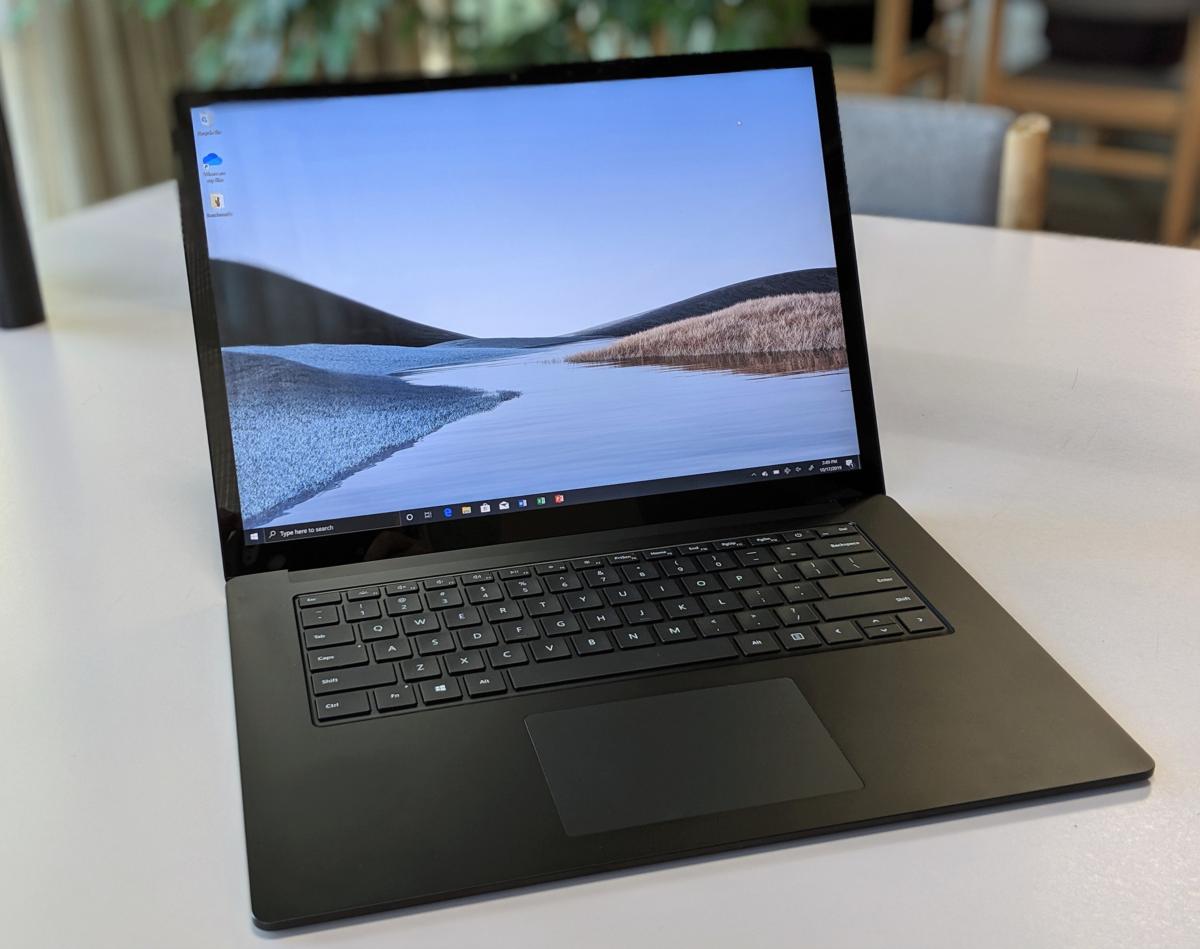 Mark Hachman / IDG
Mark Hachman / IDG
The Surface Laptop 3 in Matte Black.
Surface Laptop 3 basic specs
- Display: 13.5-inch (2256x1504) PixelSense; 15-inch (2496x1664) PixelSense (as tested); both touch-enabled
- Processor: 13-inch: Core i5-1035G7/Core i7-1065G7 (Ice Lake); 15-inch: 2.1GHz Ryzen 5 3580U Radeon Vega 9 Surface Edition /2.3GHz Ryzen 7 3780U Radeon RX Vega 11 Surface Edition (as tested)
- Graphics: 13-inch: Iris Plus 950; 15-inch: Radeon Vega 11 (as tested)
- Memory: 13-inch: 8GB/16GB LPDDR4x; 15-inch: 8/16/32GB DDR4 (16GB as tested)
- Storage: 13-inch: 128/256/512/1TB; 15-inch: 128/256/512GB M.2 SSD (512GB as tested)
- Ports: USB-C, USB-A, Surface Connect, 3.5mm jack
- Camera: 720p (user-facing); Windows Hello enabled
- Battery: 46.9Wh (tested), 45.8Wh (rated); quick-charges up to 80 percent in 1 hour
- Wireless: 13-inch: Wi-Fi 5 (802.11ax)/Bluetooth 5.0; 15-inch: 802.11ac, Bluetooth 5.0
- Operating system: Windows 10 Home (consumer, as tested) / Windows 10 Pro (business)
- Dimensions: 13-inch: 12.1 x 8.8 x 0.57 in. (14.51mm); 15-inch: 13.4 x 9.6 x 0.57 in. (14.69 mm)
- Weight: 13-inch: 2.89 pounds; 15-inch: 3.4 pounds (tested), with charger: 4.0lb
- Color: Sandstone (metal), Matte Black (as tested, metal), Cobalt Blue (Alcantara) and Platinum (Alcantara, metal)
-
Price: Orders start at $999 at Microsoft.com. $2,099 as tested
We reviewed the “consumer edition” of the Surface Laptop 3. Business users don’t receive the option of the AMD Ryzen Surface Edition processor, the custom chip that both AMD and Microsoft helped design. Instead, both the 13-inch and 15-inch Surface Laptop 3 for Business use either an Intel Ice Lake quad-core Core i5-1035G7, or a Core i7-1065G7 chip.
Pay close attention to the Surface Laptop 3 prices, though: There’s a massive $400 bump between the Ryzen 5 and the Ryzen 7 configuration, partly because of the the SSD change. One of the newer features of the Surface Laptop 3 is its ability to swap out the SSD, though it’s not exactly user-serviceable.
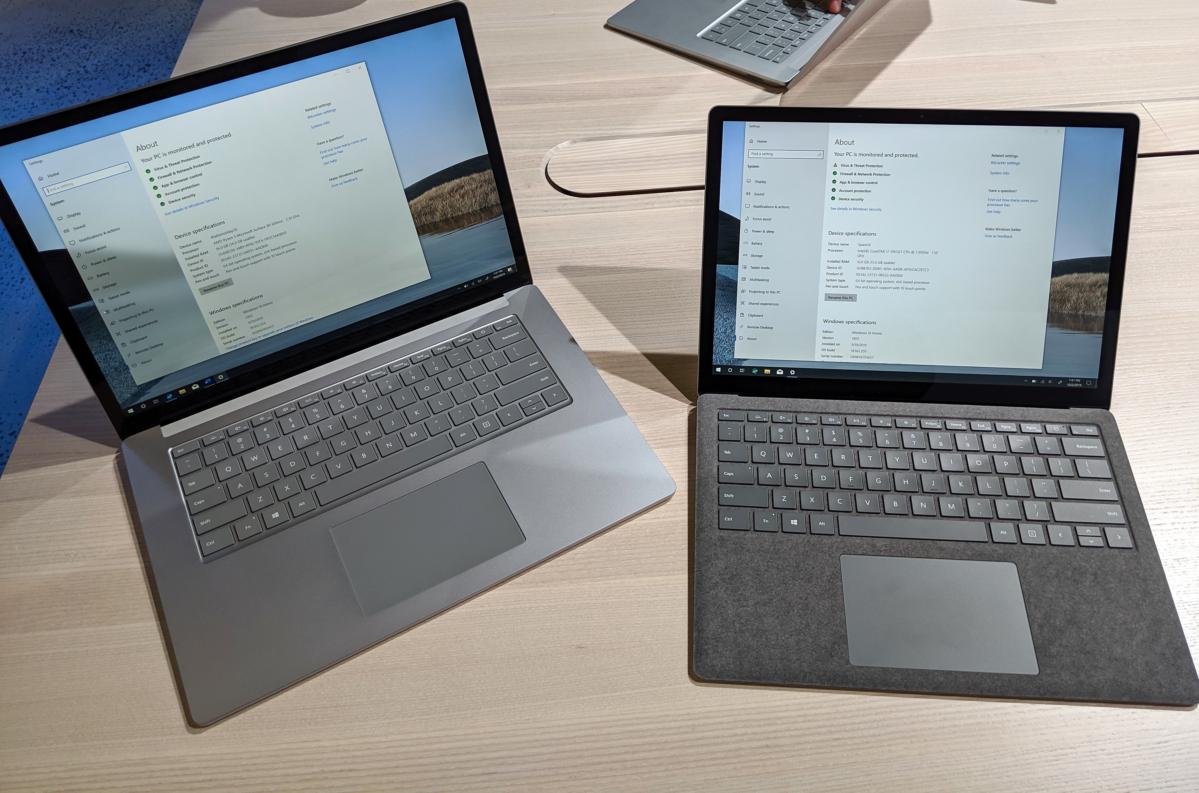 Mark Hachman / IDG
Mark Hachman / IDG
Metal or fabric? It’s your choice, though which you choose also determines which configuration of the Surface Laptop 3 you’ll receive.
A sleek, lovely design
Whereas the Surface Laptop changed little from the original to the Surface Laptop 2, a number of new updates set the Surface Laptop 3 apart: the new 15-inch form factor, of course; the AMD-based “Surface Edition” mobile Ryzen processor option; and new color and chassis options. We were offered the Matte Black 15-inch Surface Laptop 3 for review, but we also liked the dusky Sandstone option we saw at the launch.
Surface Laptops have always aspired to be more than just computing devices, and the sleek swathes of metal that inform the 15-inch Surface Laptop 3 are lovely both to view and to hold. The Surface Laptop 3 joins other laptops in its class that have moved to lighter materials, and slimmed down their internal components. It feels surprisingly light. Even Microsoft’s 65W charger is tiny. We didn’t notice any differences between the Ryzen 5 and Ryzen 7 models in terms of weight or physical design, nor did we expect to.
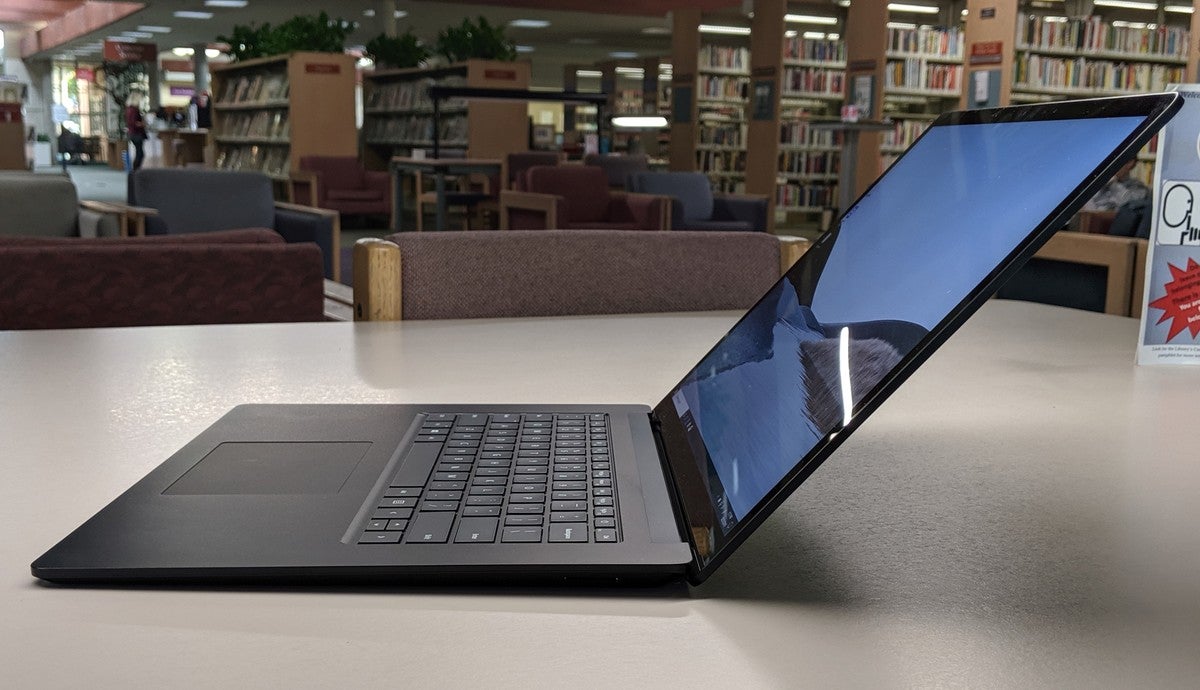 Mark Hachman / IDG
Mark Hachman / IDGAt the same time, the Surface Laptop 3 is sturdy beyond concern. It’s a standard clamshell design: It folds back to about 45 degrees off the horizontal plane like previous models, but it doesn’t go completely flat.
I definitely prefer the magnesium metal chassis introduced in the Surface Book 2 lineup, which is now featured in the Surface Laptop 3. Earlier Surface Laptops were covered in the Alcantara fabric used by the Surface Pro devices, but now you can choose between that look and bare metal. Each color is associated with a specific material, though, save for the Platinum version—or, to put it another way, our Matte Black test device was available only in the metal coating.
Personally, I like the feel of cool metal against my skin in a warm California office. Others may feel differently as the winter rolls in. Be forewarned: Black metal is a fingerprint magnet. Also keep in mind that your material options apply only to the interior of the Surface Laptop 3’s clamshell workspace. On all models, the exterior will be metal, helping the Laptop remain cool.
Not fanless, but surprisingly close
Microsoft paid attention to cooling in the Surface Laptop 3. Usually, we prefer to leave Windows’ power/performance settings just as the manufacturer left them by default. During the out-of-the-box (OOBE) setup process, the fan blew hard, with a noticeable whine. It actually revved, like a motorcycle, during one of the many updates (including Surface firmware) that Windows applied at startup. This applied to our testing of both the Ryzen 5 and Ryzen 7 versions.
After applying the updates, however, the fan largely went quiet. The default power configuration is “best battery life,” even when plugged in. But usually that means the fan will kick on sometimes. The Ryzen 7 model acts a bit more like historical Surfaces, with the fan turning on a bit more frequently, but still very quietly. The fan within Microsoft’s Ryzen 5 Surface Laptop 3 rarely turned on, a subtle point of difference between the two.
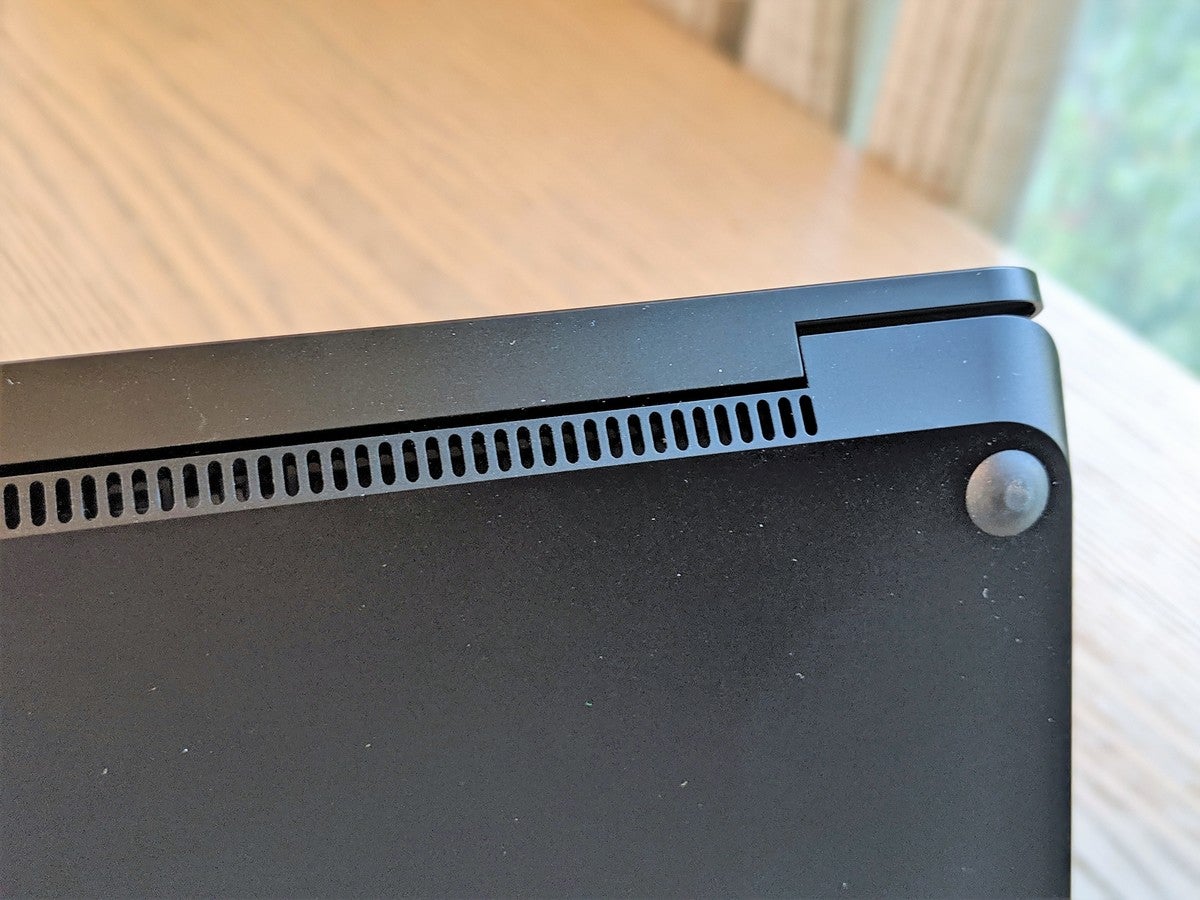 Mark Hachman / IDG
Mark Hachman / IDG
The Surface Laptop 3 15-inch seems largely passively cooled, though its fan kicks on occasionally. Theoretically, you should be able to remove the corner bumpers and the Torx screws beneath to replace the SSD, but Microsoft advises leaving this task to the professionals. Notice how the black metal quickly attracts dust, too—with other colors, it’s not as noticeable.
When the Surface Laptop 3’s fan was called to action, it turned off nearly instantly after the benchmark completed. Moreover, the bottom of the chassis never came close to being hot, let alone uncomfortable, even with the more powerful Ryzen 7 in play. . That’s remarkable.
Laptop displays have improved over the years, but the Surface displays, including the one on the Surface Laptop 3, remain among the very best. Microsoft’s bold PixelSense display puts out a blazing 373 lumens, more than most of its competition does. The 201 pixels-per-inch density of the Laptop 3’s 15-inch model remains the same as the prior generation’s 13-inch model (Microsoft didn’t offer a 15-inch Surface Laptop 2).
At the top of the display, a tiny 720p camera sits alongside depth sensors for logging in almost instantaneously with Windows Hello. The camera doesn’t offer a built-in physical shutter, so paranoid types will have to satisfy themselves with some good old-fashioned black tape.
The camera plays a role in the Surface Laptop 3’s new “instant-on” capability, which brightens the screen and turns on the camera in just a whisker after opening the Laptop from standby. Getting up and running in barely a second isn’t something that fits naturally into a list of features, but it’s darn convenient.
Adding USB-C is a plus
The other noteworthy addition to the Surface Laptop 3 is the new, long overdue USB-C port, which replaces the miniDisplayPort found on most previous Surface devices. Because Microsoft left the USB-A port alone, you won’t have to worry about connecting legacy USB hard drives, printers, and other devices. But if you’re an existing Surface owner who bought a miniDP-to-HDMI dongle, it’s obsolete withthe new product line. So, too, is Microsoft’s Surface Connector-to-USB-C dongle, or the much cheaper ecosystem of third-party chargers. But there are literally dozens of USB-C hubs to choose from, too, which offer much cheaper I/O options than the Surface Dock.
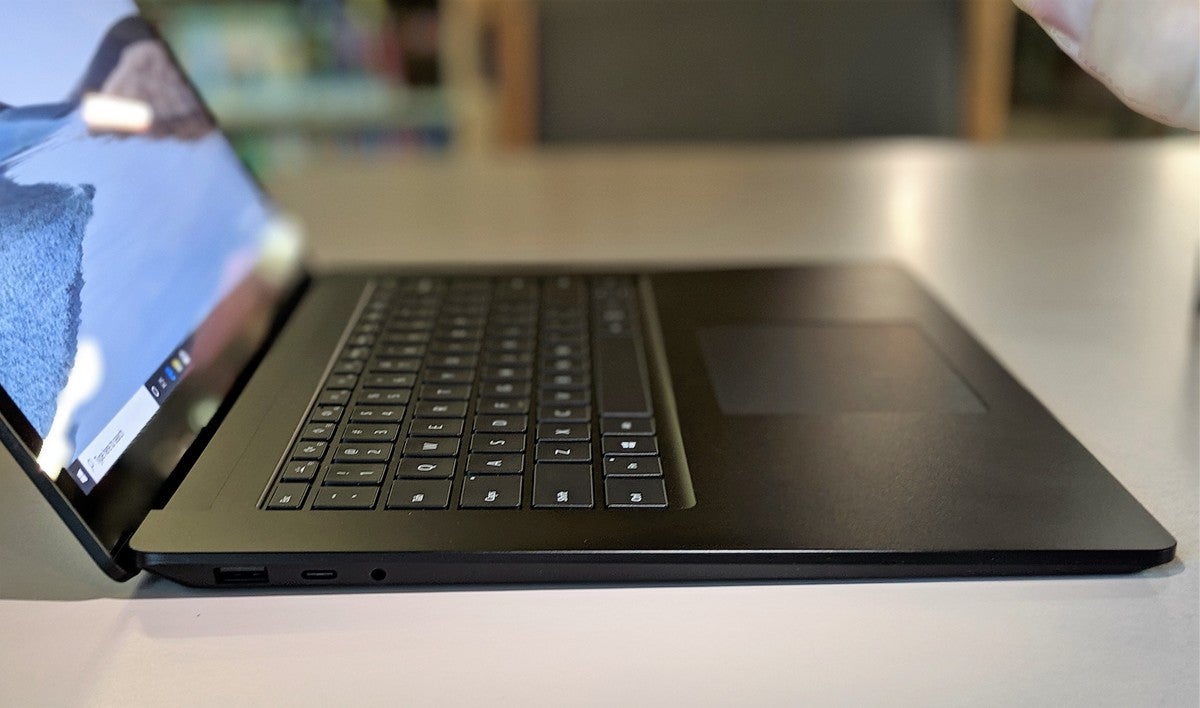 Mark Hachman / IDG
Mark Hachman / IDG
A USB-C port replaces MiniDP in the latest iteration of the Surface Laptop, the Surface Laptop 3.
Because it now sports USB-C, you can charge your Surface using a USB-C charger, rather than just the Surface charger. The ubiquity of Surface chargers has been a Surface strength, as one Surface charger basically fits all Surface devices. Still, there’s even less of a chance now that you’ll be without a plug in a pinch.
Remember, too, that this Surface Laptop 3 adds quick charging: up to 80 percent charge in an hour. We’re told by Microsoft that quick charging works across USB-C, though you’ll need the same power that Microsoft’s Surface charger provides (60W) to enable this. In testing, though, the Surface Laptop 3 fell short of Microsoft’s expectations: We drained the battery, then gave the Laptop 3 60 minutes to charge. It reached 67 percent using the stock charger.
Microsoft chose not to add Thunderbolt functionality to the USB-C port, which means that the Surface Connector, will be your primary display output to a Surface Dock. Assuming you have a Dock, that’s not critical. One underappreciated deficiency of any Surface device to date has been the inability to output to a pair of 4K monitors, at eye-pleasing 60Hz rates. The Surface Laptop 2 struggled to meet a 4K/60Hz setup with a secondary 1080p monitor, too. For those who love productivity, this was a big deal.
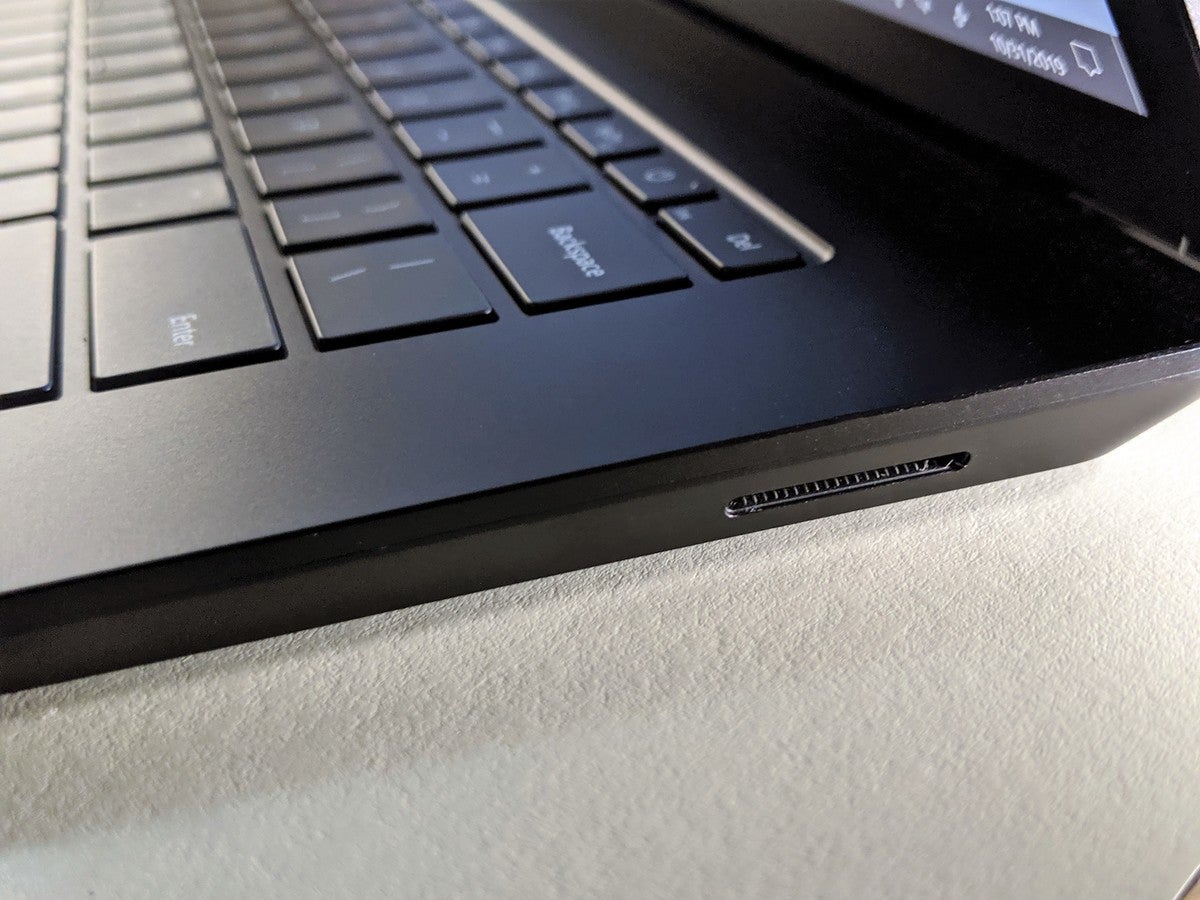 Mark Hachman / IDG
Mark Hachman / IDG
The magnetic Surface Connector, a staple of the Surface line, is still embedded in the right-hand side of the chassis and serves as an I/O connection.
I was extremely pleased to see the Surface Edition-based Laptop 3 simultaneously output to its own display, a 4K/60 setup, and a 1080p monitor with aplomb.
The keyboard and built-in speakers
Picking apart keyboard subtleties usually boils down to the spacing between the keys (the pitch), and the amount of play in the keys (the key travel). Surface keyboards are generally quite good, and the Surface Laptop 3 keyboard is no exception: Spacious keys provide a comfortable landing pad, with good resiliency. The 19mm key pitch remains unchanged. The Laptop 3’s key travel feels somewhat lesser than in the Surface Laptop 2, though, and it is: 1.3mm versus 1.5mm.
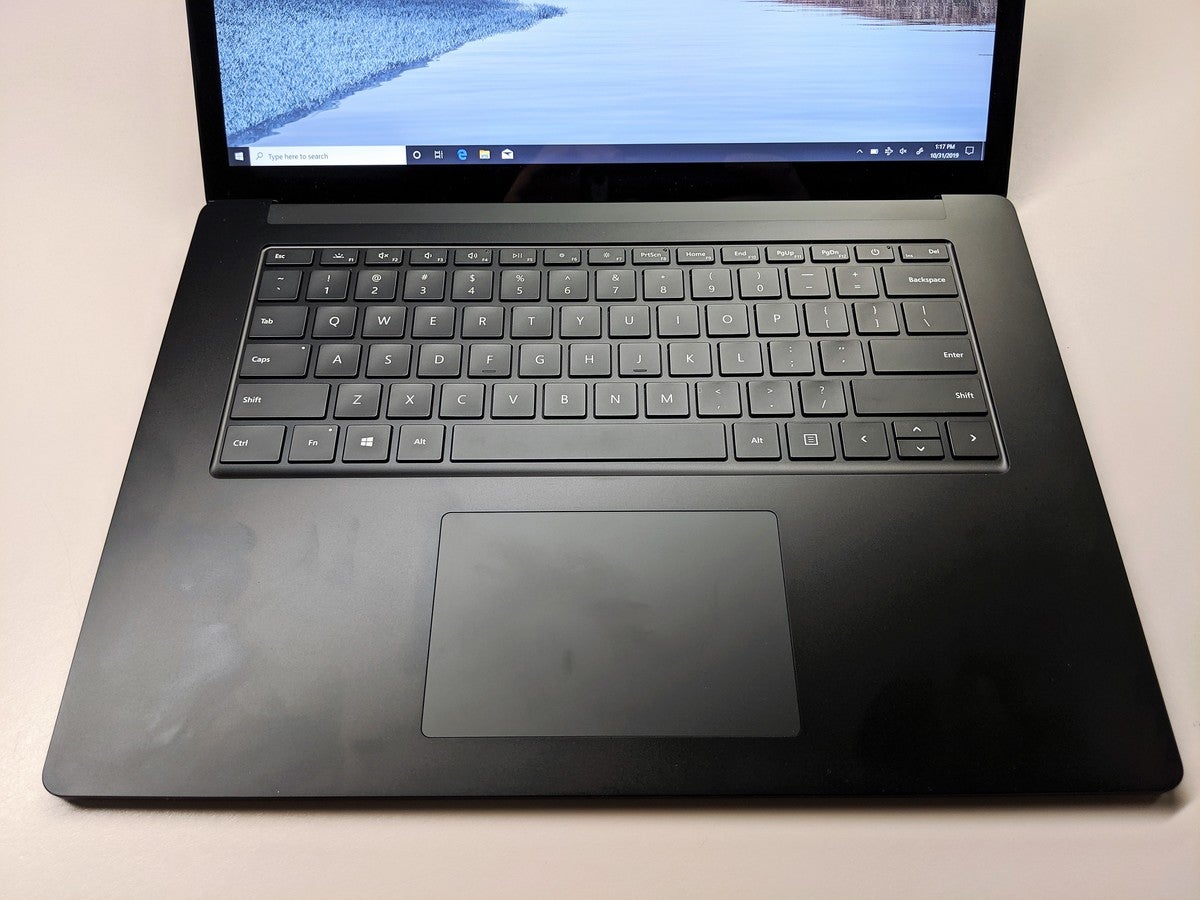 Mark Hachman / IDG
Mark Hachman / IDG
Microsoft rearranged some of the Surface Laptop 3’s function keys and slightly reduced the key travel. The metallic chassis does tend to attract fingerprints—in this photo, we polished the right side but left the left-hand side untouched.
A quick digression about Surface keyboards: The Surface Book series still provides what I consider to be the premier Surface typing experience. The first-gen Surface Book’s keys (with 1.6mm key travel) extend upward from the chassis, while the top of the Laptop’s keys are level with the chassis. That means the Laptop’s keyboard actually rests in a valley of sorts, stretching your fingers a bit further. It’s a subtlety, but subtleties distinguish good keyboards from great ones.
Microsoft also inexplicably rearranged the function keys on the Surface Laptop 3’s top row, moving the backlight key to the far left and the screen brightness keys to the middle. We like the small guide bumps that were added, though.
The Surface Laptop 3’s touchpad is 20 percent larger than the previous model’s, and it’s smooth and clickable across virtually its entire surface—less than a fingers’ breadth at the top. To be fair, you’ll probably unconsciously accommodate a trackpad that isn’t entirely clickable, but it demonstrates Microsoft’’s commitment to the basics: a good screen, a good typing experience, and so on.
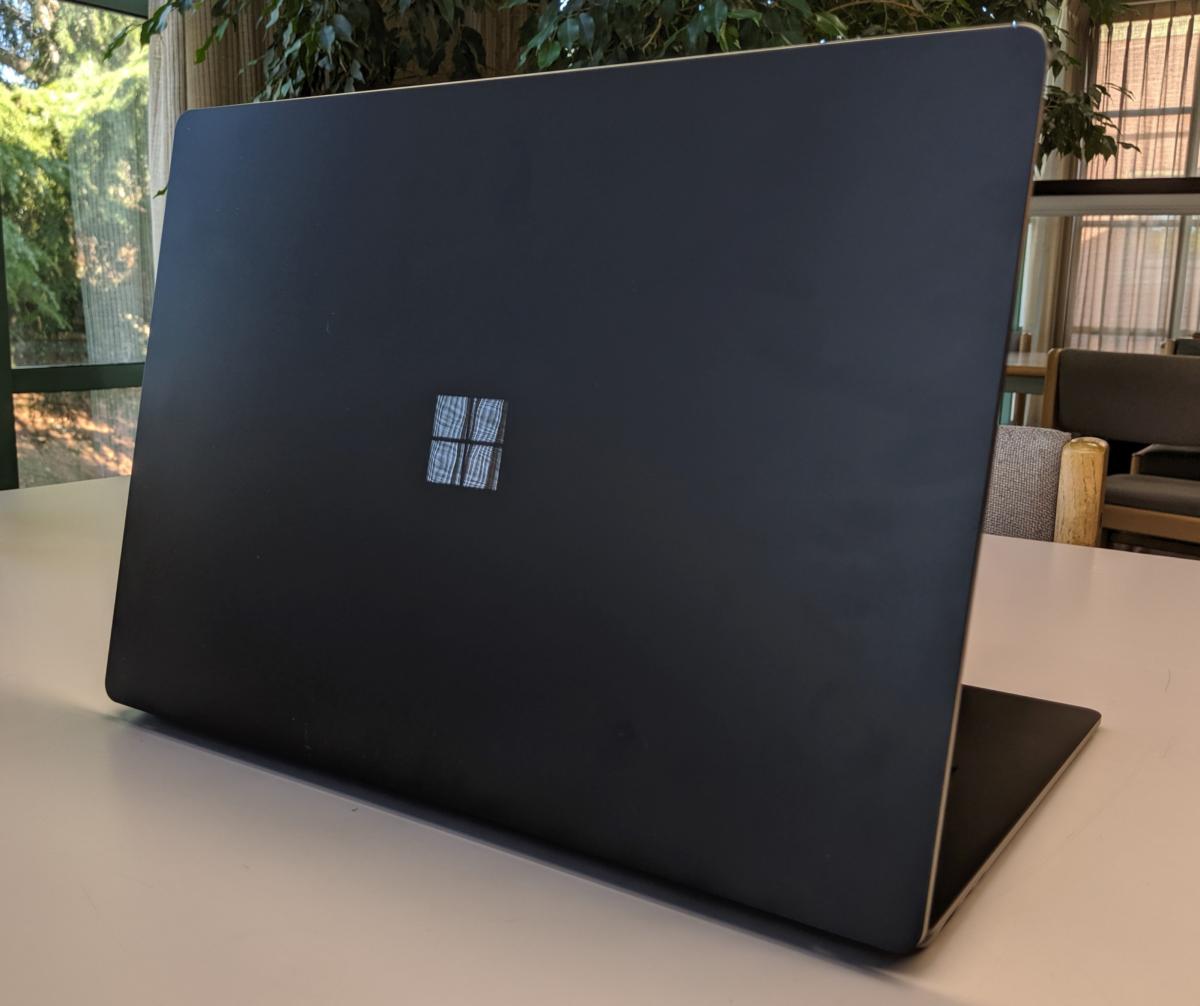 Mark Hachman / IDG
Mark Hachman / IDGMicrosoft generally isn’t shy about pumping up the jams, either. The Surface Laptop 3’s audio booms forth from a pair of “omnisonic” speakers backed by Dolby Audio Premium. Wandering through Windows’ audio controls can be a bit of a scavenger hunt. Are they in an app? Part of the Control Panel? Oddly, the Realtek audio control app didn’t appear in our Ryzen 5 test unit, but it downloaded as part of a normal Windows Store update on our Ryzen 7 machine. It’s on by default, as it should be, as it makes the sound even richer.
Nevertheless, these are speakers you won’t mind listening to music on, at all, which is saying something for laptop speakers. The Laptop 3 produces bright midrange sound, and discernable (though underpowered) bass.
Somewhat surprisingly, Microsoft restrained itself on the Surface Laptop 3's extraneous crapware, although worthless bits like Farm Heroes Saga make an appearance. Honestly, we wish Microsoft did more with the Surface app that it bundles with Surface devices. While it provides a nice summary of the system specs and provides basic configuration options for the Surface Pen (sold separately), it would be great to see something a bit more comprehensive.
 Mark Hachman / IDG
Mark Hachman / IDG
It’s probably time to freshen up Microsoft’s Surface app.
Next page: Performance benchmarks and conclusion

















